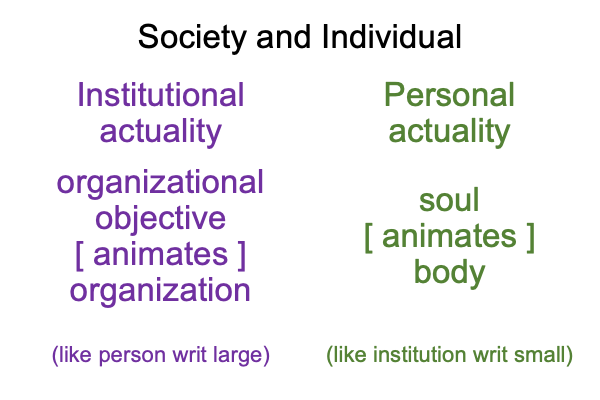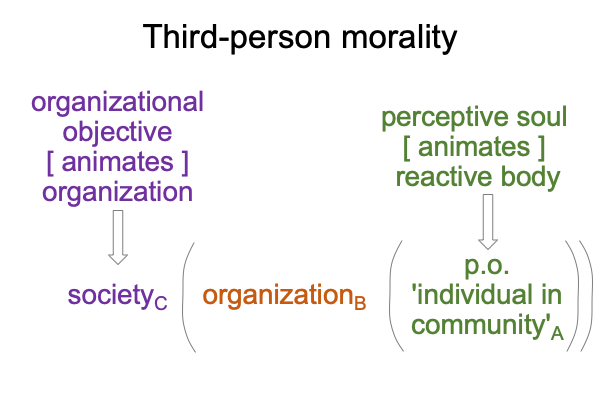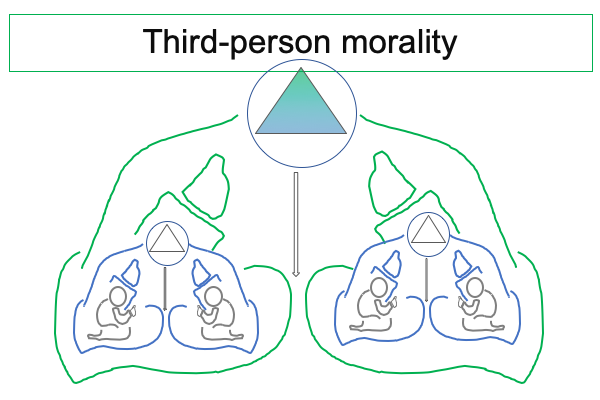0521 Well, the term, “third-person morality” is not what it first appears to be.

It may be also be called, “third-category morality”.
If second-person morality concerns the rights and the wrongs that go into productivity2H and having fun2V, in the sensible constructions of team activities, then this third-person morality must concern the rights and wrongs that go into something more than productivity2H, such as an organizational objective2H, and that go into something more than having fun2V, such as the joy of being called2V or the satisfaction of a moral identity2V.
0522 The third-person of third-person morality is not a third individual, as depicted in Figure 4.1. It is a person writ large, belonging to Peirce’s category of thirdness.
Third-person moralityC brings the actuality of second-person moralityB into relation with the potential of first-person moralityA.
Here is a picture of how each hylomorphe associates to an element in the nested form.

0523 Now, I portray a the third-person morality of Figure 4.1.

Does this look familiar?
Each gray figure in the preceding cartoon, if released from the “you-me” relationship of the team (in blue) and the institutional relationship (in green), could easily return to a primal world of power2H and affiliation2V. To any person in our current Lebenswelt, this return would be experienced as a nightmare beyond imagination.
The individuals in team-related “you-me” relations (the figures in gray) live in a world of productivity2H and having fun2V (the figures in blue). This is the sweet spot for many in our current Lebenswelt. This is a world of sensible construction. Everything makes sense because spoken words refer to things that can be pictured or pointed to.
Obviously, we all agree
Don’t we?
Sensical things consist in matter [substantiating] form. Implicit abstractions are obvious. Explicit abstractions are technical. And yet, the run-of-the-mill person senses that, if there is no third-person, our world of sensible constructionmay be swamped by inner conflict or external threat.
So, what is a common person to do in our current Lebenswelt?
Join a congregation.
Especially, join a team within that congregation.
0524 Each green figure puts more than one “you-me” relation (blue figure) into perspective. A congregation manifests something more than productivity2H and something more than having fun2V.
A government agency does not. Government does something less than productive and something less than having fun. Taxation is not the same as spontaneously sharing abundance.
Faith is the more than sweet spot for many in our current Lebenswelt. Faith is a world of social construction.
Yet, faith faces a difficulty. Nothing makes sense, because spoken words refer to things that cannot be pictured or pointed to. Nonsensical things consist in being [substantiating] form, which seems a lot like matter [substantiating] form, but who knows? Beings are relational structures, which may or may not entangle matter. So, beings can be… um… difficult to comprehend, yet seem real. Yes, spoken words can name beings, that seem actual and support implicit abstractions. These implicit abstractions then support convictions that resist analysis through explicit abstraction (using spoken words).
Which is to say, spoken words can be misleading and slippery.
And… what does that mean?
In our current Lebenswelt, a snake resides in the tree of the knowledge of good and evil.
